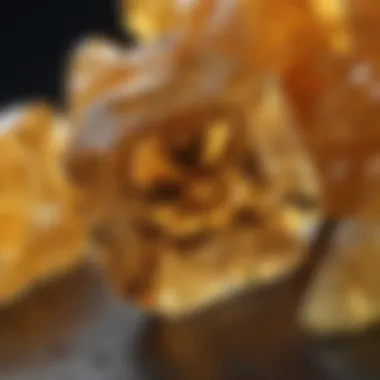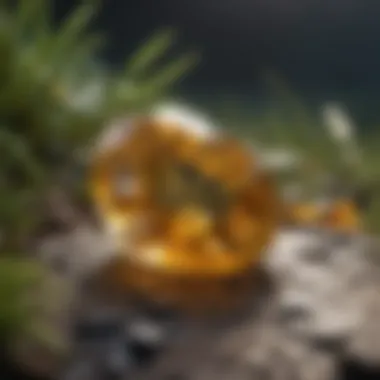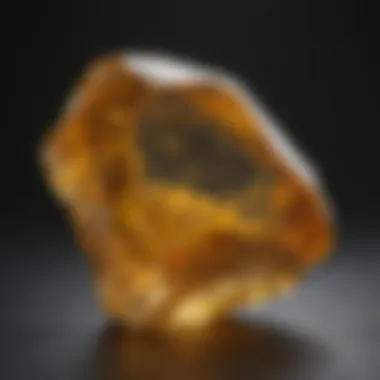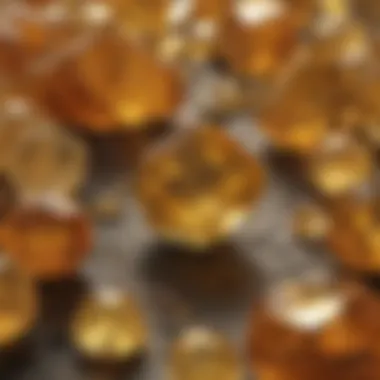Exploring the Allure of Yellow Topaz Crystals


Intro
The allure of yellow topaz is more than just skin deep; it shines brightly in the realms of geology, culture, and metaphysics. This stunning crystal, often mistaken for its more popular cousin, citrine, carries a legacy that stretches back centuries. Both collectors and enthusiasts are drawn to its warm glow, believed to symbolize clarity of thought and creativity. As we embark on this journey, we will peel back the layers of yellow topaz, revealing its geological formation, historical roots, cultural significance, and its place within metaphysical beliefs. By the end, readers should not only appreciate this mineral for its beauty but also understand its broader implications in various contexts.
History and Origins
Yellow topaz has a fascinating story that is closely tied to the earth itself. This gem is found in sedimentary and igneous rocks, formed from the slow crystallization of magma and mineral-rich waters over millennia. Its origins are often tied to the locales where it is found, with major deposits in Brazil, Sri Lanka, and Russia.
Overview of Collectibles, Rocks, and Fossils
For many rock and fossil collectors, yellow topaz represents a fascinating intersection of beauty and value. Collectors appreciate not only the aesthetic appeal of these gems but also their geological diversity. Other notable minerals that capture collectors' interest include amethyst, quartz, and garnet. However, yellow topaz stands apart with its distinctive hue and properties. Some of the key characteristics collectors look for include:
- Clarity: High-quality yellow topaz should be mostly free of inclusions.
- Color saturation: Vibrant yellows dominate the market, but deeper or lighter tones are also valued.
- Cut: Well-cut stones enhance light reflection, making the gem more appealing.
Historical Significance and Cultural Impact
Throughout history, yellow topaz has been intricately linked with various cultures. Ancient Egyptians believed yellow topaz was colored by the glow of Ra, the sun god, and used the gem as a protective amulet against evil spirits. Similar beliefs permeated other civilizations as well:
- In India, yellow topaz was revered as a stone of wisdom and was often embedded in royal jewelry.
- In medieval Europe, it was thought to possess healing powers, often used as a remedy for various ailments.
- Modern interpretations continue to maintain that it fosters both emotional healing and heightened creativity.
In today’s world, the cultural significance of yellow topaz persists. Many people wear it as a birthstone for November, aligning it with personal, emotional, and spiritual journeys.
"Yellow topaz, with its rich history, is more than just a beautiful stone. It's a bridge connecting people with centuries of belief and tradition."
Identification and Classification
Understanding how to identify and classify yellow topaz requires familiarity with its unique properties. This knowledge assists both collectors and enthusiasts in distinguishing genuine yellow topaz from other similar stones.
Guide to Identifying Rocks and Fossils
To identify yellow topaz accurately, here are some essential tips:
- Observe the color: Pure yellow topaz has a rich, vibrant yellow. Look for any signs of orange or brown, which can indicate lesser quality.
- Test hardness: Rating a 8 on the Mohs scale, yellow topaz is quite hard. If a stone can scratch glass, it is likely genuine.
- Check brilliance: High-quality topaz should exhibit a noticeable sparkle.
Common Types and Variations
While yellow topaz itself is a specific variety, several other types also deserve mention:
- Imperial Topaz: This variant showcases a beautiful pinkish-orange hue, often commanding higher prices.
- Blue Topaz: Although rare, this type can be commercially valuable, prized for its striking blue color.
- White Topaz: An often overlooked gemstone, white topaz is more subtle yet desirable for its clarity and versatility in jewelry.
With this knowledge, collectors can more easily navigate the intriguing world of yellow topaz and its variants.
Preamble to Yellow Topaz
The realm of yellow topaz is not merely a colorful avenue of gemstones; it's a vibrant tapestry that weaves through geological marvels and cultural narratives. Within this section, we will dissect the significance of yellow topaz, elucidating its unique qualities and relevance both as a mineral specimen and as a cherished gem in various traditions and practices.
Definition and Overview
Yellow topaz, a member of the silicate mineral family, is primarily composed of aluminum, fluorine, and silicon. This stunning gemstone is known for its golden hues, ranging from pale yellow to rich, vibrant amber. Unlike its blue cousin, which often captures the spotlight, yellow topaz carries its charm quietly yet confidently. Interestingly, while most people might associate this gem with luxury and adornment, its origins lie deep within the earth's crust. Formed in igneous rocks and evolved through natural processes, yellow topaz serves as a stunning example of nature's artistry.
When we talk about yellow topaz, one can't help but mention its unique optical properties. The way light dances through this gem, refracting and reflecting, brings to life an array of dazzling colors that can truly capture the attention of anyone – be they a collector or a curious onlooker.
Importance in Collecting and Geology
In the world of rock and mineral collecting, yellow topaz holds a special place. Its vibrant coloration and clarity make it highly sought after among enthusiasts, collectors, and jewelers alike. For the collector, yellow topaz is not just a specimen to display; it represents a rich history and a connection to the earth's geological processes. Each piece has its own story, a testament to the time it spent forming beneath layers of rock.


From a geological perspective, studying yellow topaz can provide insights into the conditions of its formation. Recognizing where yellow topaz is found can also reveal the geological processes at play, such as volcanic activity and mineral crystallization.
As you delve deeper into the world of yellow topaz, consider this:
"Every piece of yellow topaz is a fragment of earth’s history, a narrative etched in crystal form."
This gemstone not only captivates those who appreciate its physical beauty but also invites them to ponder the processes that created it. Its value is as much in its beauty as it is in its geological significance, creating a dual appeal that resonates with a diverse audience.
In summary, yellow topaz is more than just a pretty gemstone; it’s a canvas reflecting the dynamism of nature's history, speaking to collectors and enthusiasts alike about the intricate tapestry of our planet's geological past.
Geological Properties of Yellow Topaz
The geological properties of yellow topaz are fascinating and provide a wellspring of knowledge, essential for understanding this alluring mineral. Focusing on its chemical composition, formation, and physical characteristics enables both collectors and enthusiasts to appreciate the gem’s uniqueness and its role in various applications.
Chemical Composition
Yellow topaz is primarily composed of aluminum silicate fluoride hydroxide. This composition makes it part of the nesosilicate mineral group, which plays a significant role in determining its overall features. With the general formula Al₂SiO₄(F,OH)₂, the presence of fluorine and hydroxide in its structure contributes to its color and various properties. This intricate molecular makeup not only influences the stone's appeal but also makes it relatively rare, thus increasing its desirability among collectors. Unlike many other gemstones, the variations in its chemical structure can lead to different shades of yellow, creating a stunning palette.
Formation and Where It Is Found
The formation of yellow topaz is a multi-faceted process, often occurring in igneous and metamorphic environments. Its occurrence alongside granite or rhyolite rocks is not uncommon, which speaks to its geological origins.
Geographical Distribution
Yellow topaz can be found in several locations worldwide, including Brazil, the United States, and Russia. Each of these areas brings unique attributes to the stone. For instance,
- Brazil is renowned for its high-quality, vivid yellow topaz, often regarded as the most sought-after.
- The United States tends to yield more varied shades, with deposits found predominantly in Utah and Colorado.
- Russia’s deposits, although less famed, contribute to the overall diversity of sources.
The geographical distribution not only highlights the mineral’s broad appeal but also enables collectors to acquire specimens from various locales, each adding a narrative to its backstory.
Formation Processes
The processes by which yellow topaz forms involve both hydrothermal and pegmatitic activity. During hydrothermal processes, mineral-rich fluids can crystallize, shaping beautiful topaz forms. Conversely, pegmatitic formation occurs in deep crystallization environments, leading to larger and clearer crystals.
- This duality in formation allows for an array of colors and qualities within the yellow topaz, enhancing its allure and marketability.
The formation processes reflect nature’s versatility, demonstrating that conditions deeply shape mineral traits and availability.
Mining Practices
Mining practices for yellow topaz vary depending on its locality. In Brazil, traditional mining methods are still utilized, characterized by manual labor, while mechanized approaches dominate in larger operations. On the other hand, in the United States and elsewhere, commercial mining often targets gem-quality stones through open-pit techniques.
- This variety in mining methods brings both benefits and challenges. Local miners rely on hands-on techniques which can enhance quality through careful selection, whereas industrial mining maximizes output but can come at a cost to the environment.
- Moreover, mining regulations differ broadly between countries, impacting the sustainability of practices. The discussion here bridges the balance between demand for yellow topaz and the environmental implications of its extraction.
Physical Characteristics
Yellow topaz exhibits several physical characteristics that contribute to its allure, making it a favored choice among collectors.
Color Variations
The color of yellow topaz is generally recognized for its warm, sunny hues ranging from pale lemon to rich gold. This variation is largely influenced by the amount of chromium present.
- The deeper the yellow, the more sought after it tends to be. Collectors often seek out vibrant hues, reflecting a gem’s quality.
- Additionally, this color diversity allows for versatility in jewelry design, catering to different aesthetic preferences.
Hardness and Durability


When adding durability to the mix, yellow topaz shines with a hardness rating of 8 on the Mohs scale. This characteristic contributes significantly to its popularity in jewelry, as its resilience allows for more frequent wear without worrying about undue wear and tear.
- However, while it is sturdy, care must still be taken to avoid harsh chemicals, which can dull its surface.
Transparency and Cut
The transparency of yellow topaz can range from completely clear to slightly opaque, which enhances its aesthetic appeal. The cut of the stone plays a vital role in its brilliance, determining how effectively it captures and reflects light.
- With skilled lapidary work, cut stones can display striking sparkle, making them a favored choice for artisans creating statement jewelry pieces.
- Additionally, well-cut yellow topaz can significantly increase its market value, thus highlighting the importance of craftsmanship.
In summary, the geological properties of yellow topaz not only define its physical form but also enrich the conversation around its formation, collection, and overall significance. Understanding these facets offers key insights for collectors, allowing them to navigate their choices in a well-informed manner.
Historical Significance
The narrative surrounding yellow topaz is steeped in history, revealing much about its role across different cultures and epochs. This section helps to illuminate how this vibrant crystal has not just existed, but thrived as a cherished gem and talisman. Understanding its historical significance lays the groundwork for a deeper appreciation of yellow topaz, especially for collectors and enthusiasts who wish to grasp its multifaceted identity.
Cultural Impact of Yellow Topaz
Yellow topaz has long been associated with wealth, power, and illumination. Throughout centuries and civilizations, this gemstone has held a symbol of status. For instance, during the age of enlightenment, European aristocrats frequently adorned themselves with yellow topaz jewelry, believing that it exuded both elegance and superiority. Many cultures attributed its warm, golden hues to the sun, linking it to vitality and prosperity.
People from various regions regarded yellow topaz as a stone that could bring joy. It was believed to possess the power of happiness, often given as gifts during marriage ceremonies and festivals. This cultural lens reinforces the idea that yellow topaz is more than just a crystal; it carries with it a democratic character, bridging social gaps and connecting individuals from distinct backgrounds.
Historical Uses and Traditions
Ancient Civilizations
In ancient civilizations, yellow topaz was revered not just for its beauty but also for its supposed protective qualities. The Egyptians were among the first to recognize its charms, often adorning their sacred artifacts with yellow topaz. This practice was believed to ward off evil and misfortune. Additionally, in ancient Greece, the crystal was dedicated to the sun god Apollo, a deity associated with light and clarity. This solidifies yellow topaz’s historical value in spiritual practices and daily life.
The choice of yellow topaz by ancient civilizations as a spiritual and protective element demonstrates its significant role. It wasn’t just a fashionable piece; it was something thought to carry intrinsic power. This historical thread carries over to modern collectors, who still seek to understand and connect with these ancient beliefs through the stones they admire.
Symbolism in Folklore
Symbolism in folklore surrounding yellow topaz is rich and profound. Often, it represented knowledge, learning, and wisdom, making it the favorite of scholars. In stories, it is said that wearing yellow topaz could enhance intellect and sharpen insight. These tales emphasize the belief that yellow topaz transcends mere aesthetic appeal, acting as a conduit for mental prowess.
The unique feature of yellow topaz in folklore is its association with a metaphorical light — it’s not just a beautiful gem; it symbolizes enlightenment and clarity, providing a psychological dimension to its allure. While some may view these beliefs with skepticism, they remain a significant part of the stone's story, enriching its narrative and appeal.
In summary, understanding the historical significance of yellow topaz unveils layers of meaning that deepen our connection to this remarkable crystal. Each facet gleams with stories from ancient times, serving as a bridge between past and present for collectors and enthusiasts alike. The rich backdrop of cultural and historical narratives makes yellow topaz not just a specimen to collect but a treasure to treasure.
Modern Applications and Uses
The modern relevance of yellow topaz extends well beyond its geological attributes or historical charm. This bright gemstone has carved out a niche in contemporary society, especially in the realms of design, wellness, and spiritual pursuits. From creating striking jewelry pieces to its importance in alternative healing practices, yellow topaz holds a unique position today that can't be overlooked.
Gemstone Industry
Jewelry and Adornments
When it comes to jewelry, yellow topaz shines brightly. Its stunning golden hues make it an eye-catching gem for rings, necklaces, and earrings. Unlike other gemstones, yellow topaz offers a vibrant, sunny appearance without the steep price tag often associated with high-quality stones. Craftsmen appreciate its versatility due to its range of cuts—from classic faceted to artistic cabochons, allowing for a wide variety of designs.
Not only is yellow topaz engaging in its appearance, but it also carries a certain symbolic weight. Many consider this gemstone to be a harbinger of positive energy and prosperity, making it an appealing choice for various occasions. Anniversaries, birthdays, or just because, yellow topaz fits the bill on multiple fronts. Moreover, it can suit various styles—from modern minimalism to more elaborate vintage looks, which adds to its popularity.
"Every piece of yellow topaz contains a little bit of sunshine, embodying life and joy in its facets."
However, one must note the need for proper care. Yellow topaz may be more prone to chipping compared to diamonds and rubies. While this doesn’t diminish its appeal, prospective buyers should know how to protect their jewelry from excessive wear.
Valuation and Market Trends


The valuation of yellow topaz has been experiencing some noteworthy changes in the market. Historically overlooked compared to other precious stones, it is gaining traction primarily due to its unique characteristics and affordability. Its value hinges largely on factors such as clarity, color intensity, and the cut, which can significantly affect its market standing.
Currently, yellow topaz is increasingly seen as a best buy for gemstone collectors. As more people venture into the world of gemstones, the demand for yellow topaz continues to grow. Its striking appearance coupled with a wallet-friendly price point makes it a savvy investment for both collectors and newcomers alike.
A noteworthy point is that yellow topaz tends to hold value well when kept in pristine condition, but should you decide to let go of your piece, knowing its provenance and any certifications can make a marked difference in its resale value.
Metaphysical Aspects
Another facet of yellow topaz that captivates both enthusiasts and spiritual seekers alike is its metaphysical properties. People often turn to yellow topaz not just for its sparkling beauty but also for the beliefs surrounding its effects on the mind and spirit.
Beliefs and Practices
In many cultures, yellow topaz is associated with mental clarity and abundance. This belief boosts its presence in both personal practices and community rituals. Its yellow color symbolizes warmth and enlightenment, inspiring creativity and joy, allowing individuals to feel more confident in their pursuits. This gem is thought to enhance self-awareness, privacy, and clarity, making it a fitting choice for those on a spiritual journey.
Practitioners of various belief systems often incorporate yellow topaz into crystal healing rituals, hoping to harness its energy for personal development or emotional healing. While some may find comfort in these beliefs, it’s always essential to approach such practices with an open mind and a critical eye. Different experiences can emerge from using yellow topaz, making it a personal journey of discovery for many.
Uses in Healing and Meditation
Yellow topaz’s role in healing and meditation is another significant aspect of its modern applications. People employ this stone in meditation practices to enhance focus and promote tranquility. Many believe that holding or wearing yellow topaz can transform energy flow, helping to release negativity and invite in fresh, positive energy.
Utilizing yellow topaz in a meditation space can create an atmosphere conducive to relaxation and introspection. Its golden hue is thought to bring warmth and balance, grounding those who seek stability in their lives. Some practitioners advocate placing yellow topaz in specific areas of the home to enhance energy flow, making it a beloved stone in Feng Shui practices.
Caring for Yellow Topaz
When it comes to maintaining the beauty and integrity of your yellow topaz crystals, proper care is a must. Just like any treasured item, neglect can lead to wear and tear, diminishing the stone's luster and charm. Caring for yellow topaz not only preserves its stunning appearance but also extends its lifespan, making it a worthy addition to any collector’s trove.
Cleaning Techniques
Keeping your yellow topaz clean should be viewed as a fundamental part of its upkeep. Dust, oils from skin, and other contaminants can dull its shine, so regular cleaning is essential.
Here are some effective cleaning methods:
- Warm Soapy Water: Mix mild dish soap with warm water. Soak your topaz in this solution for a few minutes to loosen any grime. Gently scrub with a soft brush or cloth to remove lingering dust and residue.
- Avoid Harsh Chemicals: It's vital to steer clear of abrasive cleaners, bleach, or ammonia which can damage the surface or alter the hue of the gem.
- Rinse and Dry: After cleaning, rinse the yellow topaz thoroughly under running water to wash away any soap. Use a soft, lint-free cloth to pat it dry, being careful not to rub too hard, as this could scratch the stone.
- Ultrasonic Cleaners: While ultrasonic cleaners can be effective for other gemstones, caution is advisable with yellow topaz due to its natural inclusions. It's best to consult a gemologist before proceeding with this method.
“A little love goes a long way in preserving the beauty of yellow topaz; treat it well, and it will shine bright.”
Storage Recommendations
How you store your yellow topaz can make all the difference in protecting it from scratches, dullness, or even potential breakage. Collectors often underestimate the significance of proper storage. Here are some recommendations to ensure your topaz stands the test of time.
- Use a Separate Box: Ideally, store yellow topaz separately from other gemstones. This reduces the risk of scratches from harder stones. A soft pouch or dedicated jewelry box lined with fabric works wonders.
- Avoid Direct Sunlight: Long exposure to direct sunlight can fade the vibrant yellow of the topaz. Storing it in a shaded area or a dark box helps maintain its color.
- Temperature and Humidity: Keep your yellow topaz in a stable environment. Avoid drastic temperature changes or high humidity levels, which could affect the quality of the stone.
- Regular Checks: Periodically inspect your storage solution. Look for signs of deterioration or any potential hazards that could impact the crystal. Long-term care is often found in the details.
Taking these steps to properly care for your yellow topaz will not only keep it pristine but also ensure it remains a focal point of admiration in any collection.
Closure
In wrapping up our exploration of yellow topaz crystals, it's vital to underscore the significant role this mineral plays across various domains. This article has traversed through its geological makeup, historical relevance, cultural status, and even its metaphysical connections. Each aspect not only paints a vivid picture of yellow topaz but also invites appreciation for its uniqueness in the world of minerals.
Summary of Findings
The insights gleaned throughout reveal several key points:
- Geological Significance: Yellow topaz, composed mainly of aluminum silicate fluoride hydroxide, showcases remarkable properties like hardness and a rich variety of hues, making it a sought-after collectible.
- Cultural Importance: From ancient civilizations to modern metaphysical beliefs, its uses have varied widely. Yellow topaz has adorned the crowns of royalty and been considered a source of strength and healing in various cultures.
- Modern Applications: Today, its adoption in the gemstone industry, especially in vibrant jewelry pieces, confirms yellow topaz's celebrated status as a preferred gemstone.
"Yellow topaz isn't just a pretty face; it serves as a historical beacon and a focal point for spiritual endeavors."
The Future of Yellow Topaz in Collecting
Looking ahead, the future of yellow topaz in the collecting world seems promising. As collectors diversify their showcases, the demand for unique specimens is likely to grow. This mineral, with its distinctive color and storied past, positions itself as a highlight amongst other stones. The ongoing exploration within the realms of geology and metaphysical properties may also open new avenues for enthusiasts.
Collectors should consider the sourcing of specimens, as responsible mining practices gain increasing attention. Ensuring that the origins of their yellow topaz are ethical not only benefits the environment but also elevates the collector's standing within the community. Furthermore, as awareness about the healing properties and energy potentials of yellow topaz spreads, it may become sought after not just as a mineral but also for its alleged metaphysical benefits.



